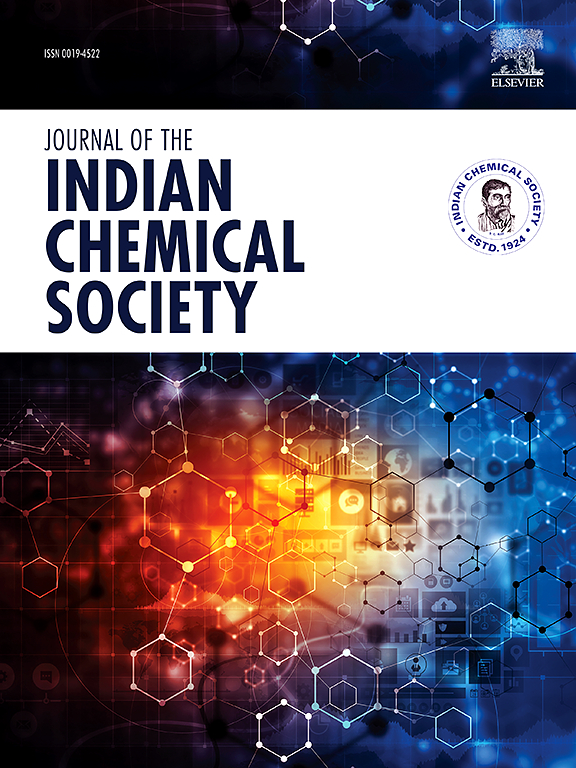Design and synthesis of di(o-chlorobenzyl) (dibromo) (1, 10-phenanthroline) tin (IV) complex and their crystal structure, comparative spectral analysis, and anticancer, cytotoxicity activity analysis
IF 3.2
4区 化学
Q2 CHEMISTRY, MULTIDISCIPLINARY
引用次数: 0
Abstract
Through the effective synthesis of di(m-methyl benzyl)tin bromide and di(o-chlorobenzyl) tin dichloride, a novel di(o-chlorobenzyl) (dibromo) (1, 10-phenanthroline) tin (IV) complex (SA2) has been successfully synthesized. Single crystal X-ray diffraction (SC XRD), nuclear magnetic resonance (NMR), and 119Sn NMR were used to identify the synthesized compound structure. The theoretical comparison of the synthesized tin complex SA2 agrees well with the theoretically determined computational data. According to the SC XRD analysis, the synthesized SA2 complex consists of two nitrogen (N) atoms and two bromide (Br) atoms located in an equatorial position, an axial position for the B atoms linked to two methyl (CH2) carbon atoms, and Sn present in a central position. It has been found that the strong binding interaction between the Sn–CH and Sn–N bonds, with Sn–Br having a calculated distance to be about 2.68 Å and 2.67 Å, and Sn–N having a distance of 2.32 Å and 2.34 Å, respectively. The functional group investigations have been determined in the experimental and theoretical models using the FTIR and Raman spectroscopy analyses, respectively. The frontier molecular orbital (FMO) study evidenced that the HOMO and LUMO band gap value of about 0.12 eV. The molecular electrostatic potential (MEP) analysis results validate the locations of electrophilic and nucleophilic attacks. The in vitro anticancer study and cytotoxicity experimental results suggested that the compound SA2 has potential anticancer activity against HeLa and Vero cell lines than the tested control anticancer drug, such as cisplatin.
二(邻氯苯)(二溴)(1,10 -菲罗啉)锡(IV)配合物的设计合成及其晶体结构,比较光谱分析,以及抗癌、细胞毒性活性分析
通过二(间甲基苄基)溴化锡和二(邻氯苯)二氯化锡的有效合成,成功合成了一种新型二(邻氯苯)(二溴)(1,10 -菲罗啉)锡(IV)配合物(SA2)。利用单晶x射线衍射(SC XRD)、核磁共振(NMR)和119Sn NMR对合成的化合物结构进行了表征。合成的锡配合物SA2的理论比较与理论计算结果吻合较好。根据SC - XRD分析,合成的SA2配合物由两个氮(N)原子和两个溴(Br)原子组成,它们位于赤道位置,B原子位于轴向位置,与两个甲基(CH2)碳原子相连,Sn位于中心位置。发现Sn-CH和Sn-N键之间存在强的结合相互作用,Sn-Br的计算距离约为2.68 Å和2.67 Å, Sn-N的计算距离分别为2.32 Å和2.34 Å。利用FTIR和拉曼光谱分析分别在实验和理论模型中确定了官能团的研究。前沿分子轨道(FMO)研究表明,HOMO和LUMO带隙值约为0.12 eV。分子静电势(MEP)分析结果验证了亲电和亲核攻击的位置。体外抗癌研究和细胞毒性实验结果表明,化合物SA2对HeLa和Vero细胞株具有潜在的抗癌活性,优于对照抗癌药物顺铂。
本文章由计算机程序翻译,如有差异,请以英文原文为准。
求助全文
约1分钟内获得全文
求助全文
来源期刊
CiteScore
3.50
自引率
7.70%
发文量
492
审稿时长
3-8 weeks
期刊介绍:
The Journal of the Indian Chemical Society publishes original, fundamental, theorical, experimental research work of highest quality in all areas of chemistry, biochemistry, medicinal chemistry, electrochemistry, agrochemistry, chemical engineering and technology, food chemistry, environmental chemistry, etc.

 求助内容:
求助内容: 应助结果提醒方式:
应助结果提醒方式:


